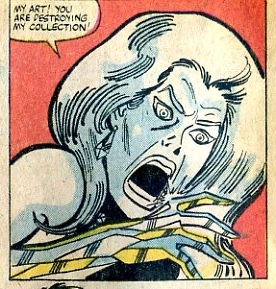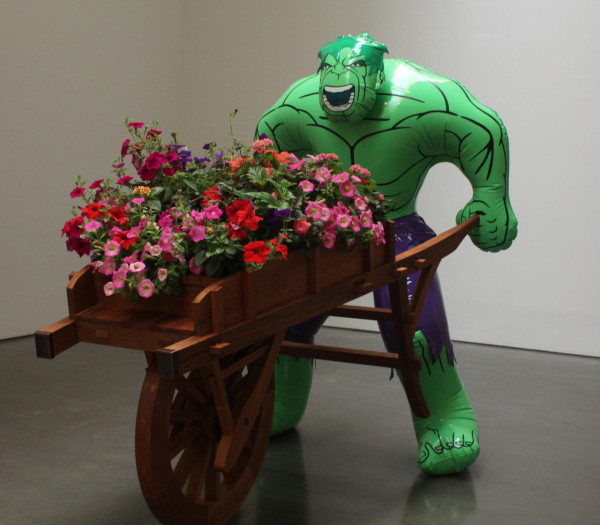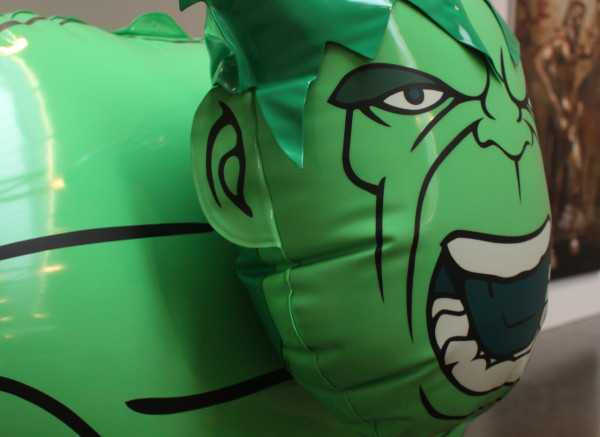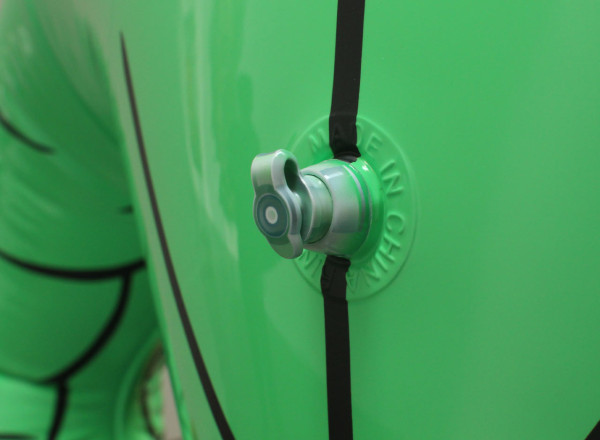Last week I wrote about an old Hulk comic in which our green protagonist crushed a female artist who wanted to appropriate him for her gallery, proving that comics are virile and manly and can kick Lichtenstein’s effeminate posterior.
So Hulk wins the battle against high art there…but in comments, Ng Suat Tong pointed me to another tussle where the victory is not so assured.
That’s “Hulk (Wheelbarrow)” a sculpture by Jeff Koons.
When I suggest that Koons has here defeated the Hulk, I mean that literally — at least in terms of the narrative of the comic I discussed last week. Again, in that issue, Bill Mantlo and Sal Buscema presented us with an evil temptress/Circe/high artist who turned her male victims into glass. She intends to do the same to the Hulk, and keep him forever in her gallery as a glass sculpture. Hulk is too big and green and pulpy to succumb to her blandishments, whether they involve sex, magic, or the granting of high art validation. So he destroys her and her house and escaped. And then, 20 odd years later, Jeff Koons gets him and puts him in a gallery anyway.
The trasformation is a little different though. Hulk isn’t turned into graceful, fragile, feminized glass. He’s a plastic inflatable — a giant toy. The act of transformation, then, is not actually transformation — it’s simply relocation. Putting the infantile, virile Hulk in a gallery turns him, instantly, into refined prettified high art, with flowers. Koons’ assault on Hulk is even more cruel and insidious than the villainnesses. The glass Circe, at least, felt that Hulk had something she wanted; she acknowledged the value of his virility by wanting to touch it with her glass creating hands and make it her own. But Koons doesn’t even have to make Hulk his; he just has to pick him up and put him in his place. If there’s any value in Hulk, it’s not in his strength, but in his ridiculousness and incongruence. He’s cheap, plastic ephemera. His incongruous worthless is his worth. He’s not a totemic real to be stolen; he’s just a ridiculous prop to be mocked.
Or so you might think. In fact, though, the Hulk is not a plastic inflatable. He’s bronze. Koons made the metal statue, then painted it to look like an inflatable. The Hulk is not a piece of plastic crap; he’s a virtuosic sculpture made to look like a piece of plastic crap.
In terms of the comic, its as if the villain had turned Hulk not into glass, but into an exact replica of the Hulk indistinguishable from the original. Except secretly made of glass. Or, for another comic-book analogy, you might remember the Harvey Kurtzman Plastic-Man, in which the imposter Plastic-Man is accepted as the real Plastic-Man since anything made out of plastic is fake. By that logic, Koons’ imitation plastic Hulk is more real than the real thing, since a kid’s fake plastic Hulks (in comics or outside them) are the real ersatz thing. Or, to put it another way, the Hulk in the gallery, by virtue of recognizing the fakeness of the Hulk in the comic, is more real than the original.
In Harold Bloom’s terms, Koons’ is a “strong” reading of the Hulk. Geoff Klock in How To Read Superhero Comics and Why points to writers like Frank Miller as “strong” rewriters, troping against the accretion of supehero continuity, so that the Dark Knight becomes, in some sense, the only Batman, “‘the powerful reading that insists on its own uniqueness and its own accuracy….[Miller] compels us to read as he reads, and to accept his stance and vision as our origin.'” Where Miller makes Batman more real and powerful and cool and coherent, though, Koons’ strong, bronze reading of Hulk is parodic. The metal Hulk insists on the actual Hulk’s transient blow-up crappiness. The amazing virtuosic reproduction of pop detritus emphasizes that it is detritus. The amount of genius and talent that Koons has put into his Hulk deliberately underlines the hackish ineptitude of Mantlo and Buscema. They ineffectually try to reproduce high art; Koons methodically and perfectly reproduces low art. There couldn’t be a much more devastating demonstration of the justness of that high-low hierarchy.
Or that’s one way of reading it, anyway. It’s worth pointing out, though, that Harold Bloom would really probably hate Jeff Koons, and vice versa. You can see Koons here as parodying the Hulk by employing the virtuosity of high art, but you could just as easily see him as employing the Hulk to parody the virtuosity of high art with its cult of “strong” Bloomian artists. Or, for that matter, you could see him as simultaneously parodying both; the serious metal sculpture disguised as a kid’s blow up doll seems to implicate both the Hulk’s hyper-masculine worship of physical power (via the ridiculous big green muscles) and the traditional art world’s hyper-masculine worship of genius (via the ridiculous virtuosity and heaviness.)
For Koons, then, high art and low art aren’t opposed. Rather, they’re both engaged in the same project of constructing a powerful ersatz masculinity — the dream of inflatable muscles made out of bronze. Koons thinks that’s funny. But he doesn’t just think it’s funny. Surely there’s some affection in those (Blooming?) flowers, picked fresh for the exhibit, and placed in a wooden wheelbarrow that is not an inflatable, nor bronze, but simply a wooden wheelbarrow. The superhero and the superartist — beneath all that roaring and posturing, they just want to give you pretty things. In the gallery or on the comics page, when Hulk smash, it means “I love you.”




Do you know how refreshing it is to read a thoughtful examination of Koons? I think the piece is successful as it brings up all these readings you mentioned. It also works especially well in comics-art discourse because Koons’ works are created by legions of anonymous, specialized workers who may or may not identify themselves as ‘artists,’ not unlike the production of mainstream comics. The major difference between the comic Hulk (or movie Hulk, or vinyl toy Hulk,) and bronze statue Hulk is that the latter wasn’t authorized by Marvel Comics. But Koons himself is a brand, but a brand that is transparent about how brands ape and plagiarize each other (as opposed to being sites of original creation.)
Also, Koons’ work could be said to be a celebration of this system, while comics has worked to successfully mitigate artist anonymity (and profit from that mitigation,) in its marketing of auteur-heroes. I’m sure I sound like a broken record on this last point… I really should write something and get this out of my system.
By this system, I mean the creation of art via an industrialized division of labor.
Good points! I should have known that Koons’ process is industrial; that makes a lot of sense. I didn’t really talk about commodification either, though I think there’s definitely a discussion to be had there re the piece. Is Hulk selling those flowers? Is he bellowing in rage, or is he bellowing to onlookers to come buy, come buy?
I don’t know a ton about Koons. I think this piece is marvelous (I showed it to my son and explained it was made out of bronze, and he thought that was the coolest thing ever.) Is he generally hated? It’s weird how thoroughly alienating people still find pop art even after several decades (as opposed to ab ex or most avant garde art, which seems pretty thoroughly assimilated by this point…)
Koons is pretty divisive, for different reasons. In the higher (funded) echelons of fine art, he’s celebrated and a crucial figure in art history. Working as one of his artists isn’t considered degrading– I’d say its more of a rite of passage for some young contemporary artists (he employs a lot of young people.) In my school’s art department, artists who value contemporary art, and its history and criticism, valued Koons. Artists/critics who are more dedicated to virtuosic, material skill can be defensive of his success, but these artists are now very alienated from contemporary discourse. And then I think others are unmoved by the grossness of his provocations (Michael Jackson, sex sculptures, etc.) — his work is kind of feeds on an idea of the art-world as carnival spectacle, a framework more alive for casual museum goers than people who deeply care about art. But this commercialism is one major trajectory of contemporary art…
This piece makes me think of Hulk as empty signifier (just full of air, but not, b/c he bronze) – like all of these classic superhero comic book characters, a kind of shell to be filled up with meaning through careful selective, erasure and the positional construction of a narrative of identity. . . All mean-looking, but loving flowers. The Hulk would probably never bellow at people to buy stuff – except perhaps in his Mr. Fix-It persona, b/c when you’ve had a character around for 50 years and written and drawn by so many different people, there are always exceptions and one-offs and re-imaginings and what ifs. . .
Personally, when I see that wagon full of flowers, I am reminded of how there was a time that despite his anger, the Hulk was also easy to try to make friends, to find understanding and love – but always fucked up and/or was betrayed. Even in the classic first appearance of Wolverine, Hulk assumes they are friends as they team up to fight Wendigo, until Wolverine turns on him. The Hulk gets angry because he his hurt. . . not physically – “Puny Human, cannot hurt Hulk!” – but emotionally.
How about a reading of that sculpture as a critique of notions of masculinity? The wagon of flowers and the blow-up doll form suggesting a kind of vulnerability that that masculine persona does not allow him to have, he must remain bronze, metallic, hard. . . Eh. . . I don’t know – I like the contradiction between appearance and materials in the piece, but aesthetically it leaves me cold – at least in pictures. Sculpture is a tactile artform, perhaps if I could be in its presence and touch it.
BTW, question: can simple HTML be used in these comments, italics and links and the line?
Simple html works in comments.
I was basically doing a gendered reading, I think, at least in part. I think it also does point to Hulk’s soft side. And definitely the idea of Hulk, or pop culture in general, as empty tropes waiting to be appropriated.
I’d love to see the piece in person, but I kind of love it even in photos. Koons has done other Hulk art too, I think.
I love the Michael Jackson piece. That was before Michael Jackson really was a pale white hue (by which I do not refer to his actual physical death).
Hulk is like the leather daddy police sergeant in Mad Max who is feeding his parrots in an apron when Max comes by to quit the force, and says “WHAT IS THIS, FUNNY WEEK?”
Koons’s fabrications differ significantly from the works of the great masters who used assistants or apprentices in that unlike an artist like Rubens, for instance, who actually did have the skills and talent needed to create a huge and beautifully painted masterwork, which is why he is great—-Koons does not. There was a piece in the NY Times magazine a while ago by a real artist who did one of the photorealistic paintings that Koons signed. But, it’s hard to cut through the worship of wealth that permeates the art world and that Koons exploits—–and they all love the fucking puppy.
Don’t you think Koons’ work is about that though? I mean, the Hulk piece seems pretty consciously about mass production and artificiality. The fact that he doesn’t do it himself is part of what the art’s about, which means it would be a different piece if he did do it himself. You could argue that the art he wants to make would be less thematically coherent if he was a virtuoso like Rubens, it seems like.
Oh…and I think you’re right about the worship of wealth. Koons is definitely talking about/thinking about/using that too. Commercialism is pretty central to pop art in every sense.
Surely “commercialism” is central to most high end contemporary art – “everyone” wants to emulate Koons, Hirst et al. Don’t think the core monetary values are that much different from Marvel/Image comics at their height. There’s a variable connection to the type of art produced.
“The fact that he doesn’t do it himself is part of what the art’s about…”
A lot of artists do this nowadays though. It’s not specific to Koons. Most people don’t really care (?). On the other hand, the Hulk statue is probably better than most Hulk comics ever produced.
Pop art is pretty well established…and yeah, having minions do the work is not unique to Koons. I still think it’s what his art is about though.
And yeah, I don’t think I’ve ever read a Hulk comic as interesting/fun/entertaining/meaningful as that statue. I liked some of the Peter David Hulks okay, but I doubt they’d hold up very well. And the original Kirbys were awful, as far as I remember.
Didn’t Warhol kick off the whole “Having a shopful of anonymous artists do most of the work” approach to art making? It certainly shifts the focus from virtuosity/”the touch of the master’s hand” to the ideas in play.
I “get” the methodology of artists like Koons—-but I couldn’t be less impressed. Yes, the way “his” Hulk appropriates and ridicules its subject is amusing. But is “amusing” worth the pricetag? Some people have money to burn, apparently. It isn’t the first go-round of appropriation for a character/property that Kirby derived from Frankenstein. But Noah described it as if Koons had laid hands on it in some way, when actually, the most he did was have a cute “germ of an idea”—-sort of like the other guy who claims to have created the Hulk on his own.
I don’t know if it’s worth the pricetag…but I don’t have to pay for it to look at the picture, luckily!
There’s also the fact that koons is a notorious plaigarist that steals others work and then sues anyone who makes work like his that might make him somewhat ‘divisive’.
(not to mention in his personal life he is absolute scum)
Do you have links re the plagiarism charge?
I read something by one of the artists who worked for Koons which suggested he was not terrible to work for. But lots of artists are horrible people in their personal life, fwiw.
He lost the plagiarism case at least in this instance:
http://observatory.designobserver.com/entry.html?entry=6467
Also read: http://www.newrepublic.com/article/art/82599/Koons-Balloon-Dog-Warhol-Duchamp-Perl-Modern-Art
I doubt if Koons is a worse human being than Richard Wagner. And yet the latter is celebrated as one of the greatest (if not *the* greatest) opera composers ever. Having said that, I’m not even remotely as interested in Koons art as I am in Wagner’s.
http://www.renaissanceconnection.org/artistslife.html
Let’s not pretend that workshops and assistants are a new idea, ppl.
“It certainly shifts the focus from virtuosity/”the touch of the master’s hand” to the ideas in play.”
A good thing, then, that Koons’ ideas are so very fresh and fertile
Like flowers!
both are rooted in bullshit, too
Nothing wrong with making something pretty out of poop. Arguably what all artists do.